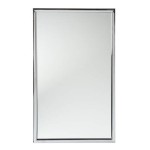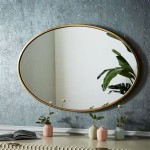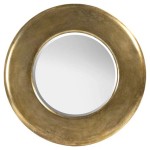Framed Mirror Ideas
Mirrors are essential design elements, serving both functional and decorative purposes. Framing a mirror elevates its aesthetic impact, transforming it from a simple reflective surface into a statement piece. Choosing the right frame can dramatically alter a room's ambiance, complementing existing decor and adding personality to a space.
A wide array of framing materials offers diverse design possibilities. Wood frames, a classic choice, provide warmth and texture. The type of wood, its finish, and the frame's profile contribute to its character. Oak and walnut offer rich, traditional aesthetics, while lighter woods like pine and maple provide a more casual feel. Painted wood frames introduce color and can be customized to match any decor scheme.
Metal frames offer sleek, modern lines and a touch of industrial chic. Materials like brushed nickel, polished chrome, and black iron provide distinct visual appeals. Thin metal frames create a minimalist look, while thicker, more ornate frames can add a sense of grandeur. The reflective qualities of metal complement the mirror's surface, creating a cohesive and sophisticated design.
Beyond wood and metal, more unconventional materials can be used for framing. Repurposed materials, like reclaimed wood or antique window frames, offer a unique, rustic aesthetic. Mosaic or tiled frames introduce intricate patterns and vibrant colors, serving as artistic focal points. Natural materials like bamboo or woven wicker contribute to a bohemian or coastal vibe.
The frame's size and shape are crucial considerations. A large, ornately framed mirror can serve as a room's centerpiece, while smaller framed mirrors can be grouped together to create a gallery wall. Round mirrors soften a space, while rectangular or square mirrors add structure. Unconventional shapes, like ovals or arches, can introduce a touch of whimsy and personality.
The style of the frame should complement the overall decor of the room. For traditional interiors, ornate wooden frames with intricate carvings or gilded details can enhance the classical aesthetic. Modern spaces benefit from sleek, minimalist frames in metal or dark wood. Farmhouse styles are well-suited to reclaimed wood frames or painted wood with distressed finishes. Coastal designs often incorporate natural materials like wicker or light-colored wood.
Positioning and placement of framed mirrors are key to maximizing their impact. Placing a large framed mirror opposite a window reflects natural light, brightening the room and creating an illusion of spaciousness. Hanging a framed mirror above a fireplace mantel creates a focal point and draws the eye upwards. Using smaller framed mirrors in hallways or entryways adds depth and functionality to these transitional spaces.
Consider the existing color palette and patterns in the room when choosing a frame. A frame's color can either blend seamlessly with the surrounding decor or provide a contrasting accent. If the room features bold patterns, a simpler frame can provide balance. Conversely, a more ornate frame can add visual interest to a room with a more neutral color scheme.
Adding a mat to a framed mirror can further enhance its aesthetic appeal. A mat creates a visual buffer between the mirror and the frame, adding depth and sophistication. The mat's color and width can be customized to complement the frame and the surrounding decor. A wider mat can make a smaller mirror appear larger and more substantial.
Beyond their decorative function, framed mirrors offer practical benefits. They can enhance natural light, create an illusion of more space, and serve as functional elements in dressing rooms or bathrooms. Strategically placed mirrors can also help to correct architectural flaws or highlight desirable features within a room.
Maintaining framed mirrors requires minimal effort. Dust frames regularly with a soft cloth. Avoid using harsh chemicals that can damage the frame's finish. For mirrors in humid environments, like bathrooms, ensure adequate ventilation to prevent moisture buildup, which can damage the frame and the mirror's backing.
Choosing the right framed mirror involves careful consideration of various factors, including the room's style, the frame's material, size, and shape, and the mirror's placement. By thoughtfully selecting a framed mirror, one can enhance a space's aesthetic appeal and create a more functional and inviting environment.
The versatility of framed mirrors allows them to adapt to diverse design schemes. From minimalist to ornate, rustic to contemporary, the options are virtually limitless. By understanding the principles of design and considering the specific needs of a space, one can select a framed mirror that perfectly complements the overall aesthetic and enhances the room's ambiance.
:max_bytes(150000):strip_icc()/bloomingdiyer-372b1cae2a6c43af917f3bea506c11da.jpg?strip=all)
20 Diy Mirror Frame Ideas To Inspire Your Next Project

15 Creative Diy Mirror Frame Ideas Projects Home Decor Mirrors

How To Frame A Mirror

Easy Driftwood Mirror The Wood Grain Cottage
:max_bytes(150000):strip_icc()/jellyandjonny1-0d407b5529474a4b9ad8ee58fc71e718.jpg?strip=all)
20 Diy Mirror Frame Ideas To Inspire Your Next Project

8 Amazing Bathroom Mirror Ideas Diy Update

30 Diy Mirror Frames Frame Easy
:max_bytes(150000):strip_icc()/confessionsofaserialDIY-bc77557a3392491d95d918348a18dc39.jpg?strip=all)
20 Diy Mirror Frame Ideas To Inspire Your Next Project

Mirror Frame Diy How To Update A Basic Bathroom Our Faux Farmhouse

How To Frame Out That Builder Basic Bathroom Mirror For 20 Or Less Design Mirrors Diy








